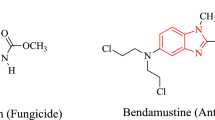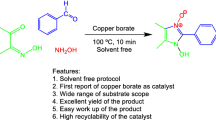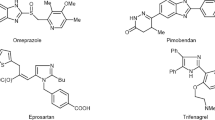Abstract
In this work, a simple and green method for the convenient synthetic protocol of 2-substituted-1H-4-carboxamide benzimidazole was reported from 2,3-diaminobenzamide and a variety of aldehydes by condensation. The results showed that 2,3-diaminobenzamide and aldehydes could react under visible light irradiation at ambient temperature in the presence of PYTZ and pumping air (or other oxidant) to obtain the desired compound with simple workup. The structures of 20 synthesized compounds were determined by NMR, IR and HRMS (new compound) techniques. The method was efficient, metal free, green, and selective.
Similar content being viewed by others
Avoid common mistakes on your manuscript.
Introduction
Benzimidazole and its derivatives have the significant importance in medicinal chemistry (Akhtar et al. 2016), such as anti-inflammatory (Monika et al. 2015; Said et al. 2015), analgesic, antifungal, bacterial, antiviral (Carrie et al. 2015), insect repellent, anti-malignant cell proliferation (Mavrova et al. 2013; Marijana et al. 2012), antihypertensive (Mukesh et al. 2013) and so on. Among compounds containing benzimidazole core, many benzimidazole carboxamide derivatives have good biological activity, such as Poly (ADP-Ribose) Polymerase Inhibitor (compounds 1 and 2, Fig. 1) (Donawho et al. 2007; Penning et al. 2010), inhibition proliferation of human breast cancer cells MX1 (compound 3, Fig. 1) (Penning et al. 2008).
The multifarious biological applications of substituted benzimidazoles have stimulated the development of numerous methodologies for their synthesis. One method is the condensation of o-phenylenediamine with carboxylic acid under the harsh dehydrating conditions (Dudd et al. 2003; Bahrami et al. 2007). The other approach is the condensation of o-phenylenediamine with aldehyde in the presence of iodobenzene diacetate (IBD) (Du and Wang 2007), HCl/H2O2 (Bahrami et al. 2007), CAN/H2O2 (Bahrami et al. 2008), polyethelence glycol (PEG-100) (Mukhopadhyay and Tapaswi 2009), (NH4)H2PW12O40 (Giri et al. 2007), CoCl2·6H2O (Khan et al. 2009), PbO2 (Rege 2010), Cp2ZrCl2 (Karhale et al. 2016). In addition, o-phenylenediamines and orthoesters could be reacted to obtain benzimidazoles through a condensation reaction under solvent-free conditions using Tungstate sulfuric acid (TSA) as catalyst (Karami and Haghighijou 2012). Mostafavi H used o-phenylenediamine and DMF to obtain benzimidazole in the presence of HMDS (Mostafavi et al. 2018). Nevertheless, most of these methodologies were associated with drawbacks such as low yields, heavy metal catalyst used, undesirable products, prolonged reaction time, and tedious workup procedure.
Recently, Samanta reported that 2-substituted benzimidazole derivatives were prepared with high yields between o-phenylenediamine and aldehydes under visible light irradiation at ambient temperature in the presence of PYTZ and aerial oxygen (Samanta et al. 2014). The use of a metal-free catalyst and visible light energy, along with the mild reaction conditions, makes this reaction an environmentally benign and energy-saving chemical process. Meanwhile, Park also reported the similar method for benzimidazoles synthesis. The reaction of o-phenylenediamine and aldehydes in methanol proceeds at room temperature with only natural sources, molecular oxygen and visible light (LEDs) (Park et al. 2014). Our group has been interested in the bio-activity of benzimidazole derivatives. Therefore, to obtain a wide variety of benzimidazole derivatives for bioactivity evaluation,the following method was adapted to synthesize any 2-substituted-1H-7-carb-oxamide benzimidazole effectively (Scheme 1).
Experimental
Chemistry
Unless specified otherwise, all starting materials and reagents were obtained from commercial suppliers without further purification. All melting points were taken on a METTLEE TOLEDO MP90 melting point apparatus and were uncorrected. 1H NMR and 13C NMR spectra were recorded on a Bruker AVANCE III HD 400 MHz instrument using TMS as the internal standard. Abbreviations used for peak multiplicities are s: singlet, d: doublet, t: triplet, q: quadruplet and m: multiplet. Coupling constants J are in Hertz and the chemical shifts were given in parts per million (ppm) and calibrated with DMSO-d6 (residual solvent signals). IR spectra were recorded as KBr pellets on a VERTEX 80/Raman II FTIR spectrometer. Mass spectra were recorded on a Triple TOF™ 5600+ (AB SCIEX USA). The reactions were monitored by thin-layer chromatography (TLC) using silica gel GF254. Photochemical reactor (Phchem III) was obtained from Beijing NBET Technology Co., Ltd.
Synthesis and characterization
General procedure for the synthesis of 2-substituted-1H-4-carboxamide benzimidazole derivatives 3 a–t
In a dark environment, a mixture of 2,3-diaminobenzamide (1.51 g, 10 mmol), PYTZ (20 mg), and ethanol (200 mL) was taken in an open pear-shaped bottle, stirred magnetically at room temperature, and then aldehyde (10 mmol) was added slowly in 2 min. The bottle was exposed to visible light (Xenon, 10 A) under stirring condition. The reaction was monitored by TLC. After the reaction completed, the reaction mixture was transferred to a three-neck bottle outside of the photochemical reactor and air was introduced to ensure that the intermediate was completely oxidized. Then, the solvent was evaporated in vacuum to 40 mL until the solid appeared. The mixture was cooled down in an ice bath for crystallization, filtration. The crude solid was recrystallized from 25 mL ethanol (30 °C) to get the target products.
Result and discussion
In our previous work, we had synthesized a lot of 2-substituted benzimidazoles to evaluate their biological activity by Samanta’s method. To further carry out our project, we decided to introduce the amido group to benzene ring to synthesize more 2-substituted-1H-4-carboxamide benzimidazole derivatives based on the previous experiences and using similar reaction sequence.
Our initial efforts were focused on optimization of reaction conditions based on the literatures (Samanta et al. 2014; Park et al. 2014). But there was a difference in their methods. In Samanta’s method, the visible light and PYTZ were dispensable to synthesize 2-substituted benzimidazole using o-phenylenediamine and aldehyde. In the absence of visible light, PYTZ showed no catalytic activity; and in the absence of PYTZ, the reaction did not proceed under identical conditions. But Park reported that PYTZ was not necessary in this reaction. To demonstrate the role of visible light and PYTZ in our research, the reaction between 3,4-toluylenediamine and 4-chlorobenzaldehyde was considered as the model reaction for investigating and several experiments were conducted in Table 1.
At first, the protocol reaction was carried out with free catalyst under dark condition. To our surprise, the reaction could occurr to provide the product with 39% in 3 h (Table 1, entry 1), which was contrary to the conclusions reported in the literature (Samanta et al. 2014). We speculated that amide group, an electron-withdrawing group, at 2,3-diaminobenzamide ring, could promote the reaction easily. To increase the reaction yield, we considered to change the light intensity in our research. It was found that the yield gradually increased with the light intensity increasing (Table 1, entries 1–3). When the electron current was increased from 5 to 10 A (Table 1, entries 2–3, entries 6–7), the intensity of the Xenon light was increased. The reaction time was shortened, but the final yield was not greatly affected. Under the same reaction time, the yield was decreased from 62 to 54% using LEDs (Park et al. 2014) as the light source (Table 1, entry 4).
Based on the above experiments, the catalyst, PYTZ, was added in reaction mixture and the reactions were carried out under different light intensities (Table 1, entries 5–8). It was found that PYTZ could promote the reaction with higher yield and short reaction time. The addition of PYTZ as the catalyst in the dark increased the yield from 39 to 63% (Table 1, entries 1 and 5). In addition, the yield was increased from 62 to 77% when the electric current was 5 A using Xenon lamp as light source (Table 1, entries 2 and 6), and the yield was increased from 64 to 75% when the electric current was 10 A with reducing time for from 2 to 1 h (Table 1, entries 3 and 7). According to Park’s procedure LEDs as light source (Park et al. 2014), the addition of PYTZ also made the yield increase from 54 to 64% (Table 1, entries 4 and 8). In addition, blocking ultraviolet light using filter glass when the electric current was 10 A using Xenon lamp as light source, the action also could proceed with 46% yield (Table 1, entry 9). Therefore, it was believed that Xenon lamp was a more suitable light source and PYTZ was a good catalyst for this reaction.
As reported in the literatures, oxygen can be used as an oxidant (Chen et al. 2013) or as a co-oxidant (Nagasawa et al. 2014; Lee et al. 2015) in the reactions by opening the flask (Park et al. 2014; Lee et al. 2015) or pumping in air (Chen et al. 2013). In our research, when the amount of 2,3-diaminobenzamide was 1 mmol (Table 1, entries 1–9), the oxygen in the air could meet the needs to complete the oxidation process by opening the flask. When the reaction was scaled up from 1 to 10 mmol, the oxidation process was very difficult to occur completely. For example, when 10 mmol of 2,3-diaminobenzamide was used in the reaction (Table 1, entry 10), 2,3-diaminobenzamide and 4-chlorobenzaldehyde were disappeared to form two new spots on TLC after 1 h (Rf = 0.55, 0.45, hex/EtOAc, 2:3).After the air was continuously bubbled into the reaction mixture by a small pump at a speed of 100 bubbles per minute on average, one spot on TLC disappeared, and another spot turned into big one on TLC(Rf = 0.45, hex/EtOAc, 2:3), which was verified by NMR as the target compound.
After investigating the influence of different reaction parameters on the model reaction, we turned our attention towards the synthesis of benzimidazole derivatives using 2,3-diaminobenzamide and a variety of aldehydes, and the results are summarized in Table 2.

Reaction of both electron-rich or -poor aromatic aldehydes provided the corresponding benzimidazoles in good yields (Table 2, entries 1–13, 15–16). In addition, aliphatic aldehydes (Table 2, entries 14,19 and 20) and five-membered heterocyclic aldehydes (Table 2, entries 17 and 18) were also the suitable substrates for the process, which proves the reaction efficiency. The simple and metal-free one-pot mild conditions allowed the reaction of aldehydes that contain a range of functional groups. As was evident from Table 2, when 2,3-diaminobenzamide reacted with o-nitrobenzaldehyde (Table 2, entry 5), oxygen in the pumping air could not oxidize the C–N single bond to C=N, and the obtained compound was 2-(2-nitrophenyl)-2,3-dihydrogen-1H-benzo[d]imidazole-4-carboxamide (Scheme 2, A). The nuclear magnetic data of A were as follows: 1H NMR (400 MHz, DMSO-d6) δ 8.91 (s, 1H, CONH2), 8.36 (dd, J = 7.7, 1.5 Hz, 1H, CONH2), 8.09 (dd, J = 8.1, 1.2 Hz, 1H, Ar–H), 7.91–7.82 (m, 2H, NH), 7.76 (td, J = 7.7, 1.4 Hz, 1H, Ar–H), 7.56 (dt, J = 8.0, 1.5 Hz, 1H, Ar–H), 7.24 (d, J = 1.3 Hz, 1H, Ar–H), 7.22 (d, J = 1.2 Hz, 1H, Ar–H), 6.67 (s, 2H, Ar–H), 6.59 (td, J = 7.8, 0.8 Hz, 1H, CH); 13C NMR (100 MHz, DMSO-d6) δ 171.43 (CONH2), 153.99 (C-2′), 149.60 (C-1′), 146.01 (C-8a), 136.81 (C-5′), 133.93 (C-6′), 132.07 (C-4′), 130.67 (C-9a), 130.55 (C-3′), 128.63 (C-6), 124.80 (C-7), 120.32 (C-5), 115.20 (C-4), 114.67 (C-2). HRMS calcd for C14H12N4O3 [M+1]+ 285.0988, found 285.0982. When the reaction temperature raised to 40 °C, and 30% H2O2 (4 mL) was added to the reaction solution, compound A was oxidized to the desired product after 0.5 h (Scheme 2, 3e). [Rf (A) = 0.7, Rf (3e) = 0.6, hex/EtOAc, 1:2] This was consistent with the proposed reaction mechanism of PYTZ-catalyzed synthesis of benzimidazole (Samanta et al. 2014). It was possible that the electron cloud density of the benzimidazole ring was lowered due to the presence of a strong electron-withdrawing group –NO2, making the entire structure more stable and difficult to be oxidized. When 2,3-diaminobenzamide reacted with n-hexanal (Table 2, entry 14), it produced many by-products without any oxidation time, resulting in a lower yield, which is probably because the activity of n-hexanal was too high to occur the side reactions more easily.
From the data in Table 2, it was found that the reaction time was longer than that reported in the literature (Samanta et al. 2014). It was possible that the amide group –CONH2 at the benzene ring affected the reactivity of the amino group with aldehyde. The mechanism needs further study. Comparing the corresponding 2-disubstituted benzimidazoles under the same reaction of Table 2, it was found that, when the reaction was scaled up, there was no difference in the reaction time, (Support information, Table 1, entries 1,7,10 and 11). However, the yield of target product could increase by pumping air (Support information, Table 1, entry 11). In other words, our method was very mature and simple. Furthermore, the structures of the synthesized 2,4-disubstituted benzimidazole derivatives were confirmed by IR, 1H and 13C NMR and HRMS analysis (Table 3).
Conclusions
We describe a one-pot, simple, and efficient for the synthesis of benzimidazole derivatives using 2,3-diaminobenzamide and a variety of aldehydes, not only aryl aldehydes, at ambient temperature by using PYTZ. The amide group –CONH2 at the benzene ring affected the reactivity of the amino group with aldehyde,which made the reaction time longer and the oxidation more difficult. The present protocol offers several advantages such as operational simplicity, mild reaction conditions, green and metal free, a simple experimental and workup procedure.
References
Akhtar W, Khan MF, Verma G et al (2016) Therapeutic evolution of benzimidazole derivatives in the last quinquennial period. Eur J Med Chem 126:705–753. https://doi.org/10.1016/j.ejmech.2016.12.010
Bahrami K, Khodaei MM, Kavianinia I (2007) A simple and efficient one-pot synthesis of 2-substituted benzimidazoles. Synthesis. https://doi.org/10.1055/s-2007-965878
Bahrami K, Khodaei MM, Naali F (2008) Mild and highly efficient method for the synthesis of 2-arylbenzimidazoles and 2-arylbenzothiazoles. J Org Chem 73:6835–6837. https://doi.org/10.1021/jo8010232
Carrie W, Brian E, James W et al (2015) Benzimidazole analogs inhibit respiratory syncytial virus G protein function. Antivir Res. https://doi.org/10.1016/j.antiviral.2015.06.016
Chen GF, Shen HD, Jia HM, Zhang L-Y et al (2013) Eco-friendly synthesis of 2-substituted benzimidazoles using air as the oxidant. Aust J Chem 66(2):262. https://doi.org/10.1071/ch12458
Donawho CK, Luo Y, Luo Y et al (2007) Abt-888, an orally active poly(adp-ribose) polymerase inhibitor that potentiates dna-damaging agents in preclinical tumor models. Clin Cancer Res 13(9):2728–2737
Du LH, Wang YG (2007) A rapid and efficient synthesis of benzimidazoles using hypervalent iodine as oxidant. Synthesis. https://doi.org/10.1002/chin.200726115
Dudd LM, Venardou E, Garcia-Verdugo E et al (2003) Synthesis of benzimidazoles in high-temperature water. Green Chem 5:187–192. https://doi.org/10.1039/B212394K
Giri BY, Prbavati Devi BLA, Gangadhar KN et al (2007) Simple and efficient method for the synthesis of benzimidazole derivatives using monoammonium salt of 12-tungstophosphoric acid. Synth Commun 3:2331–2336. https://doi.org/10.1080/00397910701410681
Jeans F, Ines H, Thomas M et al (2015) Use of substituted 2-amidobenzi- midazoles, 2-amidobenzoxazoles and 2-amidobenzothiazoles or salts thereof as active substances against abiotic plant stress. US Patent 2015216168(A1)
Karami B, Haghighijou Z (2012) Tungstate sulfuric acid: preparation, characterization, and application in catalytic synthesis of novel benzimidazoles. Chem Pap 66(7):684–690. https://doi.org/10.2478/s11696-012-0152-4
Karhale S, Patil K, Bhenki C et al (2016) Zirconocene catalyzed synthesis of 2-substituted benzimidazole derivatives. Res Chem Intermed 42(10):1–12. https://doi.org/10.1007/s11164-016-2534-7
Khan AT, Parvin T, Choudhury LH (2009) ChemInform Abstract: a simple and convenient one-pot synthesis of benzimidazole derivatives using cobalt(II) chloride hexahydrate as catalyst. Synth Commun 40(51):2339–2346. https://doi.org/10.1080/00397910802654815
Lee YS, Cho YH, Lee S et al (2015) Significant facilitation of metal-free aerobic oxidative cyclization of imines with water in synthesis of benzimidazoles. Tetrahedron 71(4):532–538. https://doi.org/10.1016/j.tet.2014.12.043
Marijana H, Gordana P, Grace K (2012) Synthesis, crystal structure determination and antiproliferative activity of novel 2-amino-4-aryl-4,10-dihydro[1,3,5]triazino [1,2-a]benzimidazoles. J Mol Struct 1007:242–251. https://doi.org/10.1016/j.molstruc.2011.10.054
Mavrova AT, Wesselinova D, Vassilev N et al (2013) Design, synthesis and antiproliferative properties of some new 5-substituted-2-iminobenzimidazole derivatives. Eur J Med Chem 63:696–701. https://doi.org/10.1016/j.ejmech.2013.03.010
Monika G, Punam G, Deepika U et al (2015) Benzimidazole derivatives: search for GI-friendly anti-inflammatory analgesic agents. Acta Pharm Sin B 5(4):337–342. https://doi.org/10.1016/j.apsb.2015.05.003
Mostafavi H, Islami MR, Ghonchepour E et al (2018) Synthesis of 1H-1,3-benzimidazoles, benzothiazoles and 3H-imidazo[4,5-c]pyridine using DMF in the presence of HMDS as a reagent under the transition-metal-free condition. Chemical Papers. https://doi.org/10.1007/s11696-018-0540-5
Mukesh C, Sharma S, Nitendra K et al (2013) 3D QSAR kNN-MFA studies on 6-substituted benzimidazoles derivatives as nonpeptide angiotensin II receptor antagonists: a rational approach to anti-hypertensive agents. J Saudi Chem Soc 17:167–176. https://doi.org/10.1016/j.jscs.2011.03.005
Mukhopadhyay C, Tapaswi PK (2009) ChemInform abstract: water-mediated synthesis of 2-substituted benzimidazoles by boric acid and glycerol. ChemInform 40(32):140–144. https://doi.org/10.1071/ch08309
Nagasawa Y, Matsusaki Y, Hotta T et al (2014) Aerobic photooxidative synthesis of benzimidazoles from aromatic aldehydes and diamines using catalytic amounts of magnesium iodide. Tetrahedron Letters 55(48):6543–6546. https://doi.org/10.1016/j.tetlet.2014.10.001
Park S, Jung J, Cho EJ (2014) Visible-light-promoted synthesis of benzimidazoles. Eur J Org Chem 2014(19):4148–4154. https://doi.org/10.1002/ejoc.201402141
Penning TD, Zhu GD, Gandhi VB et al (2008) Discovery and sar of 2-(1-propylpiperidin-4-yl)-1-benzimidazole -4-carboxamide: a potent inhibitor of poly(adp-ribose) polymerase (parp) for the treatment of cancer. Bioorg Med Chem 16(14):6965–6975. https://doi.org/10.1016/j.bmc.2008.05.044
Penning TD, Zhu GD, Gong J et al (2010) Optimization of phenyl-substituted benzimidazole carboxamide poly(adp-ribose) polymerase inhibitors: identification of (s)-2-(2-fluoro-4-(pyrrolidin-2-yl)phenyl)-1H-benzimidazole-4-carboxamide (a-966492), a highly potent and efficacious inhibitor. J Med Chem 53(8):3142–3153. https://doi.org/10.1021/jm901775y
Rege P (2010) Mild and efficient synthesis of benzimidazole using lead peroxide under solvent-free conditions. Synth Commun 41(1):58–62. https://doi.org/10.1080/00397910903531789
Said A, Zakaria K, Nermine A et al (2015) Synthesis, molecular docking and anti-inflammatory screening of novel quinoline incorporated pyrazole derivatives using the Pfitzinger reaction II. Bioorg Chem 58:104–116. https://doi.org/10.1016/j.bioorg.2014.12.003
Samanta S, Das S, Biswas P (2014) Photocatalysis by 3,6-disubstituted-s-tetrazine: visible-light driven metal-free green synthesis of 2-substituted benzimidazole and benzothiazole. J Organ Chem 45(15):11184–11192. https://doi.org/10.1021/jo401445j
Acknowledgements
Project supported by the Jiangsu Prospective Joint Research Project (No. BY2016066-02) and College Students Innovation Project (No. 201410324014Z).
Author information
Authors and Affiliations
Corresponding author
Additional information
Publisher's Note
Springer Nature remains neutral with regard to jurisdictional claims in published maps and institutional affiliations.
Electronic supplementary material
Below is the link to the electronic supplementary material.
Rights and permissions
About this article
Cite this article
Zhang, LJ., Yang, K., Li, CY. et al. A simple and metal-free one-pot synthesis of 2-substituted-1H-4-carboxamide benzimidazole using 3,6-di(pyridin-2-yl)-1,2,4,5-tetrazine(PYTZ) as catalyst. Chem. Pap. 73, 2697–2705 (2019). https://doi.org/10.1007/s11696-019-00821-x
Received:
Accepted:
Published:
Issue Date:
DOI: https://doi.org/10.1007/s11696-019-00821-x







